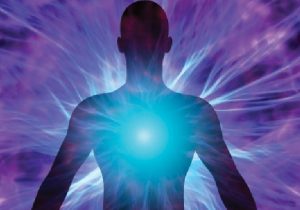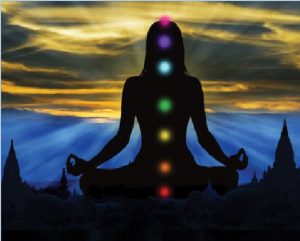 The mystery of a living thing, its complexity and grandeur are not in the atoms that go into it, but in the way, those atoms are put together. It is a slightly intriguing novelty that if anyone were to pick oneself apart with tweezers, one atom at a time, one would produce a mound of fine atomic dust, none of which had ever been alive but all of which had once been that anyone. Sooner or later every one of us breathes an atom that has been breathed before by anyone you can think of who has lived before us — Gautam Budhha, Mahavir, Mahatma Gandhi, or Osama Bin Laden. The Sanatan Dharm Seers have in their teachings through Upnishads have reiterated that this Cosmos was a stage in which always the same actors — the atoms — played their parts, differing in disguises and groupings, but without change of identity. And these actors were endowed with immortality. Perhaps this eternal revelation through Super Consciousness prompted Issac Newton to expound on the law of indestructibility of matter.
The mystery of a living thing, its complexity and grandeur are not in the atoms that go into it, but in the way, those atoms are put together. It is a slightly intriguing novelty that if anyone were to pick oneself apart with tweezers, one atom at a time, one would produce a mound of fine atomic dust, none of which had ever been alive but all of which had once been that anyone. Sooner or later every one of us breathes an atom that has been breathed before by anyone you can think of who has lived before us — Gautam Budhha, Mahavir, Mahatma Gandhi, or Osama Bin Laden. The Sanatan Dharm Seers have in their teachings through Upnishads have reiterated that this Cosmos was a stage in which always the same actors — the atoms — played their parts, differing in disguises and groupings, but without change of identity. And these actors were endowed with immortality. Perhaps this eternal revelation through Super Consciousness prompted Issac Newton to expound on the law of indestructibility of matter.
A Greek by the name Democritus, also popularly known as the “laughing philosopher” of Abdera, expounded that “The first principles of the universe are atoms and empty space. Everything else is merely thought to exist. The worlds are unlimited. They come into being and perish. Nothing can come into being from that which is not nor pass away into that which is not. Further, the atoms are unlimited in size and number, and they are borne along in the whole universe in a vortex, and thereby generate all composite things — fire, water, air, earth. For even these are conglomerations of given atoms. And it is because of their solidarity that these atoms are impassive and unalterable. The sun and the moon have been composed of such smooth and spherical masses, that is, the atoms, and so also the soul, which is identical with reason.”
Now taking up discussion on the human body and wondrous effects of Maya thereon. Factually, based on an adult man’s typical volume, one might conclude that the human body contains 15 trillion cells. So if one picks volume or weight, one gets drastically different numbers. Making matters worse, human bodies are not packed with cells in a uniform way, like a jar full of a candy apple. On an estimated one million cells in the human body die every second. That means in one day, approximately 1.2 kg of cells die. But it’s nothing to worry about. Quite the opposite; it would be a real problem if the cells in the human body did not die. Cell death is a completely natural part of the body’s recycling of cellular building blocks and it is actually a precondition for life. Old and broken cells must be taken away. Parts of cells that have broken down, or were not right from the start, need to be removed.
So cell death is a very important part of the body’s quality and sanitation system that clears away the old and broken bits and replaces them with new ones. Problems arise, however, when something goes wrong with the cell death process. In the case of cancer, cells refuse to die and grow into a tumor. In diseases such as Alzheimer’s or Parkinson’s, the opposite occurs: brain cells die even though they are not supposed to. Today there are more than 50 diseases in which scientists know that the whole reason, or a major part of it, is related to a failure of balance in cell death. This has made research into different types of cell death the most prolific area of research in the world during the past decade. However, a very important fact cannot be lost sight of that some 34 trillion cells cooperate for decades, giving rise to a single human body instead of a chaotic war of selfish microbes, is amazing. The evolution of even a basic level of multi-cellularity is remarkable enough. But our ancestors went way beyond simple sponge-like anatomy, evolving a vast collective made of many different types. To understand that collective on a deep level, we need to know how big it really is.
 The four main classes of organic compounds called macromolecules (carbohydrates, lipids, proteins, and nucleic acids) that are essential to the proper functioning of all living things are known as polymers or macromolecules. All of these compounds are built primarily of carbon, hydrogen, and oxygen but in different ratios. This gives each compound different properties. Familiar nucleic acid forms are DNA and RNA. A very glaring example of ever-elusive Maya lies in the fact that the same number of atoms combined in the same way produces the same crystalline form, and the same crystalline form is independent of the chemical nature of the atoms and is determined only by their number and relative position. How, why, and from where these four basic elements got these qualities has not so far been answered by the scientists.
The four main classes of organic compounds called macromolecules (carbohydrates, lipids, proteins, and nucleic acids) that are essential to the proper functioning of all living things are known as polymers or macromolecules. All of these compounds are built primarily of carbon, hydrogen, and oxygen but in different ratios. This gives each compound different properties. Familiar nucleic acid forms are DNA and RNA. A very glaring example of ever-elusive Maya lies in the fact that the same number of atoms combined in the same way produces the same crystalline form, and the same crystalline form is independent of the chemical nature of the atoms and is determined only by their number and relative position. How, why, and from where these four basic elements got these qualities has not so far been answered by the scientists.
Proteins, the name with which everyone is very familiar in mundane affairs, are complex molecules composed of amino acids and necessary for the chemical processes that occur in living organisms. Proteins are basic constituents in all living organisms. Proteins constitute about 80 percent of the dry weight of muscle, 70 percent of that of skin, and 90 percent of that of blood. The interior substance of plant cells is also composed partly of proteins. The importance of proteins is related more to their function than to their amount in an organism or tissue. Enzymes, another familiar name to all, are in fact, proteins and may occur in very minute amounts; nevertheless, these substances catalyze all metabolic reactions, enabling organisms to build up the chemical substances — other proteins, nucleic acids, carbohydrates, and lipids — that are necessary for life. Although amino acids may have other formulas, those in protein invariably have the general formula RCH(NH2)COOH, where C is carbon, H is hydrogen, N is nitrogen, O is oxygen, and R is a group, varying in composition and structure, called a side chain. Amino acids are joined together to form long chains; most of the common proteins contain more than 100 amino acids. Some proteins, such as hemoglobin, are composed of more than one protein subunit (polypeptide chain).
Proteins can interact with many types of molecules, including with other proteins, lipids, carbohydrates, and DNA. As estimated average-sized bacteria contain about 2 million proteins per cell. Common examples are E. Coli and Staphylococcus aureus. Smaller bacteria contain fewer molecules, on the order of 50,000 to 1 million. Yeast Cells have been estimated to contain about 50 million proteins and human cells on the order of 1 to 3 billion. Out of about 20,000 or so proteins encoded by the human genome, only 6,000 have been detected in specialized cells. Other organisms like Eukaryotes have 15,000, bacteria have 3,200, archaea have 2,400, and viruses have 42 proteins on average coded in their respective genomes. The best-known role of proteins in the cell is as enzymes, which catalyze chemical reactions. Enzymes carry out most of the reactions involved in metabolism, as well as manipulating DNA in processes such as DNA replication, DNA repair, and transcription.
Despite differences in the structure and function, all known proteins found in human body have a similar basic molecular formula C NH 1.58 ± 0.015nN 0.28 ± 0.005nO 0.30 ± 0.007nS 0.01 ± 0.002n. The general formula of protein is RCH(NH2)COOH, where C is carbon, H is hydrogen, N is nitrogen, O is oxygen, and R is a group, varying in composition and structure, called a side chain. Now referring to Viruses, which though invisible to the eye but having a catastrophic effect on humanity have just caused tremors all over the world over as Covid-19, are not made out of cells. A single virus particle is known as a virion, and is made up of a set of genes bundled within a protective protein shell called a capsid. Viruses are not plants, animals, or bacteria, but they are the quintessential parasites of the living kingdoms. Although they may seem like living organisms because of their prodigious reproductive abilities, viruses are not living organisms in the strict sense of the word. Without a host cell, viruses cannot carry out their life-sustaining functions or reproduce. Viruses are generally classified by the organisms they infect, animals, plants, or bacteria. Since viruses cannot penetrate plant cell walls, virtually all plant viruses are transmitted by insects or other organisms that feed on plants.
Fungi, which is another entity infesting the human body, are usually made up of a single cell as in the case of yeasts, or multiple cells, as in the case of mushrooms. The bodies of multi-cellular fungi are made of cells that band together in rows that resemble the branches of trees. Some fungi can cause serious diseases in humans, several of which may be fatal if untreated. Furthermore, persons with immuno-deficiencies are particularly susceptible to various diseases by the fungi, which can attack eyes, nails, hair, and especially skin and cause local infections such as ringworm and athlete’s foot. Fungal spores are also a cause of allergies of different kinds. Then comes a reference to Bacteria, the very familiar entity infesting the human body and causing various ailments, are the smallest and “simplest” cells. Their composition is perhaps a better gauge of the indispensable chemical makeup of “the cell” than might be a specialized human cell. It is estimated that about 70 per cent of its weight comprises of water (meaning Hydrogen & Oxygen), DNA 1 per cent, RNA 6 per cent, Nucleotides 0.4 per cent, Aminoacids 0.4 per cent, Carbohydrates 3 per cent, Lipids 2 per cent, Ions 1 per cent, Waste Products 0.2 per cent.
Now coming to the constituents of most of the foods that are fondly ingested by humans, the most familiar name is that of carbohydrates. It’s a type of macromolecule, which forms an essential part of our diet; grains, fruits, and vegetables are all-natural sources of carbohydrates. Carbohydrates provide energy to the body, particularly through glucose, a simple sugar that is a component of starch and an ingredient in many staple foods. Carbohydrates also have other important functions in humans, animals, and plants. Carbohydrates can be represented by the stoichiometric formula (CH2O)n, where n is the number of carbons in the molecule. In other words, the ratio of carbon to hydrogen to oxygen is 1:2:1 in carbohydrate molecules. This formula also explains the origin of the term “carbohydrate”: the components are carbon (“carbo”) and the components of water (hence, “hydrate”). Carbohydrates are classified into three subtypes: monosaccharides, disaccharides, and poly-saccharides.
Glucose, Fructose, and Galactose are common monosaccharides — galactose is found in milk sugars and fructose is found in fruit sugars. though all have the same chemical formula (C6H12O6), they differ structurally and chemically. Another familiar carbohydrate is Glycogen, which is the storage form of glucose in humans and other vertebrates and is made up of monomers of glucose. Glycogen is the animal equivalent of starch and is a highly branched molecule usually stored in liver and muscle cells. Cellulose, another prominent carbohydrate, is the most abundant natural biopolymer. The cell wall of plants is mostly made of cellulose; this provides structural support to the cell. Wood and paper are mostly cellulosic in nature. Another fascinating interplay of Carbon, Hydrogen, and Oxygen in the human body, is the familiar Lipids, which have a much lower proportion of water than other molecules such as carbohydrates. Lipids are a heterogeneous group of organic compounds that are insoluble in water and soluble in non-polar organic solvents. They naturally occur in most plants, animals, microorganisms, and are used as cell membrane components, energy storage molecules, insulation, and hormones.
Milk is the commonest example that can be cited when discussing lipids. As per the latest findings, milk is believed to around 400 lipids comprising at least 16 fatty acids in it depending upon its natural source. Butter has exceptionally complex lipids and fatty acids in it. Although lipids are composed primarily of carbon and hydrogen, yet many lipid molecules may also contain oxygen, nitrogen, sulfur, and phosphorous. Lipids serve numerous and diverse purposes in the structure and functions of organisms. They can be a source of nutrients, a storage form for carbon, energy-storage molecules, or structural components of membranes and hormones.
Lipids comprise a broad class of many chemically distinct compounds, which are large, non-soluble in water molecules. Phospholipids make up cell membranes. Lipids also serve as waxy coverings (cuticle) on plants, pigments (chlorophyll), and steroids. Lipids have more carbon and hydrogen atoms than oxygen atoms. Fats are made of glycerol (alcohol) and three fatty acid chains. This subunit is called a triglyceride. Phospholipids have a “water-loving” hydrophilic head and two “water-fearing” hydrophobic tails. Nucleic acids carry genetic information in a cell. DNA or deoxyribose nucleic acid contains all the instructions for making every protein needed by a living thing. RNA copies and transfers this genetic information so that proteins can be made.
Steroids a class of natural or synthetic organic compounds characterized by a molecular structure of 17 carbon atoms arranged in four rings, which are important in biology, chemistry, and medicine and they vary from one another in the nature of attached groups, the position of the groups, and the configuration of the steroid nucleus (or gonane). Small modifications in the molecular structures of steroids can produce remarkable differences in their biological activities. The steroid group includes all the sex hormones, adrenal cortical hormones, bile acids, and sterols of vertebrates, as well as the molting hormones of insects and many other physiologically active substances of animals and plants. Among the synthetic steroids of therapeutic value are a large number of anti-inflammatory agents, anabolic (growth-stimulating) agents, and oral contraceptives. Other prominent and familiar examples of steroids include progesterone (promoting gestation), androgens (favoring the development of masculine characteristics), and cardio-tonic steroids (facilitating proper heart function).
Most of the fat found in food is in the form of triglycerides, cholesterol, and phospholipids. Some dietary fat is necessary to facilitate absorption of fat-soluble vitamins (A, D, E, and K) and carotenoids. Humans and other mammals have a dietary requirement for certain essential fatty acids, such as linoleic acid (an omega-6 fatty acid) and alpha-linoleic acid (an omega-3 fatty acid) because they cannot be synthesized from simple precursors in the diet. Some diet protagonists who claim to manage diseases through re-jigging only the diet intake. The fundamental assumption is that we are cellular 100 percent human. Let’s say wheat and dairy removed, which is the very most common diet for kids or adults afflicted with certain disease syndromes?
The first idea is that food causes allergic symptoms of varying severity, viz., from chronic diarrhea or constipation, etc. The problem with this approach is that the body is not 100 percent human. Again it is a straightforward idea. The reality is far more sophisticated than that. The number problem I see with diets is that. All that bacterial matter in our bodies adapts to the removal of foods to survive. We print about every 25 years. Bacteria can reproduce with adaptation within hours. You see, bacteria have as much survival instinct as we do. It even has a better survival instinct than we do. Because they can reproduce a lot faster than us. On top of this, you also have parasites. All of this biological matter communicates by sending chemical messages between each other. And so now you can begin to understand that diets can only have a limited effect. Once you remove a portion of food, all of these five components recombine themselves. So that they can survive and disease takes over again. The disease is more profound than the level of food.
The idea people have in their minds is that some pathogen comes in our pristine body environment. And creates symptoms that make us uncomfortable. And all we have to do is take an antibiotic that is going to kill that one thing. Then the human body is 100 percent human again. Children are over medicated. I see parenting medication when the fever is barely 99. If we look at the figures, you see the introduction of antibiotics. It’s a complete lie. But that is what most people have in their minds. And this image cannot be underestimated. That is precisely what most people see. It is a powerful image that creates a deep connection between our psyche and the good folks.
In reality, we have no idea what happens in the body. When we introduce an antibiotic. In the incredibly complex biological soup, our bodies are. We are the result of three billion years of evolution. What happens to bacteria. Viral and fungal matter in the mouth. In the eyes and the nose, in the heart, in the liver, in the brain, in the gut, the spleen, etc. All of this we have we don’t have a clue. We owe our lives to what lives inside of us. It keeps us alive. We are a product of evolution, not only merely biological. But also bioelectrical growth built upon in layers to gain higher open consciousness. Disease, in my humble view, is a disruption of all of that.
Having interacted on various aspects of the structure of the atom vis-à-vis my focus on the concept of Maya, through this article, which is last in this series, I grope to find suitable expressions in which I can make myself. However, I find myself much in the same position as a sailor, marooned on a remote island where conditions differ radically from anything he has ever known and where, to make things worse, the natives speak a completely alien tongue. To put it short, Maya remains Maya, an enigma.
letters@tehelka.com












